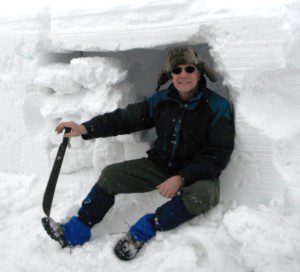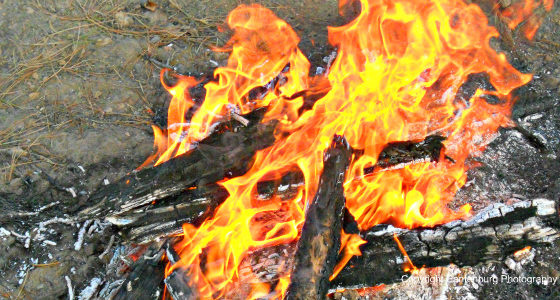If you think one of those big South American knives is only good in the jungle or rain forests, think again!
A machete can be a very useful tool for winter survival shelters.
by Leon Pantenburg
The Oregon blizzard was sending snow sideways in the Cascades and the igloo was nearing completion. The snow blocks had to be angled just right to finish the cap. My machete did the job very well.
A month earlier, about 2,500 miles away, with the temperature at least 70-80 degrees warmer, I used a machete in the middle of a bamboo thicket. The plants grew at thick as hairs on a dog’s back (a little Mississippi vernacular, here,) and I needed several cane poles. We were visiting Grandma and Grandpa in Vicksburg, and the day was so pretty we just had to go fishing.

This under-construction igloo was built using several survival tools, including a machete. (Pantenburg photo)
I had mono filament line, hooks, bobbers and bait, and some quick work with a machete got us all poles. (If you’ve never fished for bream, with a cane pole, bobber and hook baited with a worm from a tin can, you don’t know what you’re missing!)
A machete is a big knife, with blade lengths ranging from 12-14 inches on up to about 24 inches. (Much longer than that, and I suppose the classification would have to be changed to “sword”!) Various websites defined a machete as: “…a large, heavy knife used in Central and South America as a weapon or for cutting vegetation. A machete is a large cleaver-like cutting tool. The blade is typically long and usually thick.”
You can use a machete to build snow shelters, cut through jungle vegetation, and clear brush. You can split wood with a machete – just pound it, with the grain of a log with a wooden stick or baton. A machete in your hand might deter a potential mugger or looter.
I have several, mainly because they are cheap and versatile. At the last gun show, I got a machete for $3. I didn’t need it, but enjoyed the bartering and dickering to get the price I wanted! Once sharpened and cleaned up, my $3 gun show special will be a quality survival tool. At some point, a Boy Scout will use it to build a snow or brush shelter.
My machetes are mostly used for shelter building, so I usually tie a bright-colored piece of paracord and flagging on the handle so they don’t get lost.
Today, machetes range in price and quality. I stopped at a local sporting goods store on the way home from the gunshow, and could have bought a new machete with canvas sheath for $8.99. But quality comes with a price. You can get a high end machete for a higher price from such knife companies as Gerber and Cold Steel, and can expect to pay between $20 and $50.
Like most survival tools, a machete is multi-purpose, but it doesn’t shine in all areas. If you anticipate splitting a lot of wood, get an axe. (And know how to use it! An axe or hatchet relies on velocity to work, so you have to swing it hard! If your aim is inaccurate, the blade can ricochet off the log or branch and be very dangerous.)
For gathering wood for the evening campfire, I prefer a saw over any other portable tool. While a hatchet is very dangerous to the untrained user, it’s considerably harder to hurt yourself with a saw.
And if you’re on the arctic tundra, desert or above the treeline where the only firewoods is scrubby bushes and shrubs, get a hand clipper. You can gather a lot of twigs and small branches for fires quickly with a clipper, and there is virtually no danger in using one.
Machetes have a few inherent flaws. Like an axe, they rely on velocity to cut and chop, so there is always the danger of poorly-aimed strokes. The cheaper ones may have poor steel. Sharpening a machete is important, and because of the length of the edge, can be quite a chore.
But, like any survival tool, a machete may have its place in your survival gear or car survival kit. The option is certainly worth considering!
Please click here to check out and subscribe to the SurvivalCommonSense.com YouTube channel – thanks!







Leave a Reply